Maritime Shipping Industry Assignment
Added on 2020-04-21
21 Pages4704 Words39 Views
Running head: MARITIME SHIPPING INDUSTRY
Maritime Shipping Industry
Name of the Student:
Name of the University:
Author Note:
Maritime Shipping Industry
Name of the Student:
Name of the University:
Author Note:
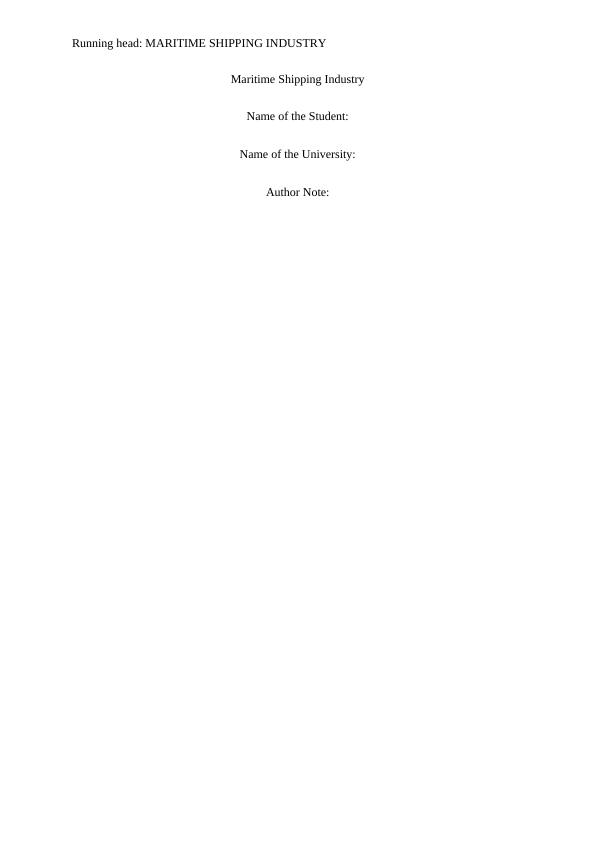
1
MARITIME SHIPPING INDUSTRY
Table of Contents
Introduction:...............................................................................................................................3
Factors affecting supply and demand in shipping freight market:.............................................3
Types of shipping freights:.....................................................................................................4
Container Cargo:................................................................................................................4
Liquid bulk:........................................................................................................................4
Dry bulk:............................................................................................................................4
Break bulk:.............................................................................................................................4
Ro-ro:.....................................................................................................................................4
Cargo related issues:..............................................................................................................5
Vessel related issues:..............................................................................................................8
Sailing related issues:.............................................................................................................9
Port related issues:..................................................................................................................9
International agreements between countries:.......................................................................10
Formation of freight rate in tramp market:..............................................................................11
Difference between freight and hire:....................................................................................11
Differences between tramp markets and pre-arranged chartered ocean liners:.......................11
Difference between Bareboat charter and Time or Voyage charter:....................................12
Contracts of affreightment:..................................................................................................12
Established trade routes:......................................................................................................13
Interaction between demand and supply curve in determining equilibrium prices:................14
MARITIME SHIPPING INDUSTRY
Table of Contents
Introduction:...............................................................................................................................3
Factors affecting supply and demand in shipping freight market:.............................................3
Types of shipping freights:.....................................................................................................4
Container Cargo:................................................................................................................4
Liquid bulk:........................................................................................................................4
Dry bulk:............................................................................................................................4
Break bulk:.............................................................................................................................4
Ro-ro:.....................................................................................................................................4
Cargo related issues:..............................................................................................................5
Vessel related issues:..............................................................................................................8
Sailing related issues:.............................................................................................................9
Port related issues:..................................................................................................................9
International agreements between countries:.......................................................................10
Formation of freight rate in tramp market:..............................................................................11
Difference between freight and hire:....................................................................................11
Differences between tramp markets and pre-arranged chartered ocean liners:.......................11
Difference between Bareboat charter and Time or Voyage charter:....................................12
Contracts of affreightment:..................................................................................................12
Established trade routes:......................................................................................................13
Interaction between demand and supply curve in determining equilibrium prices:................14
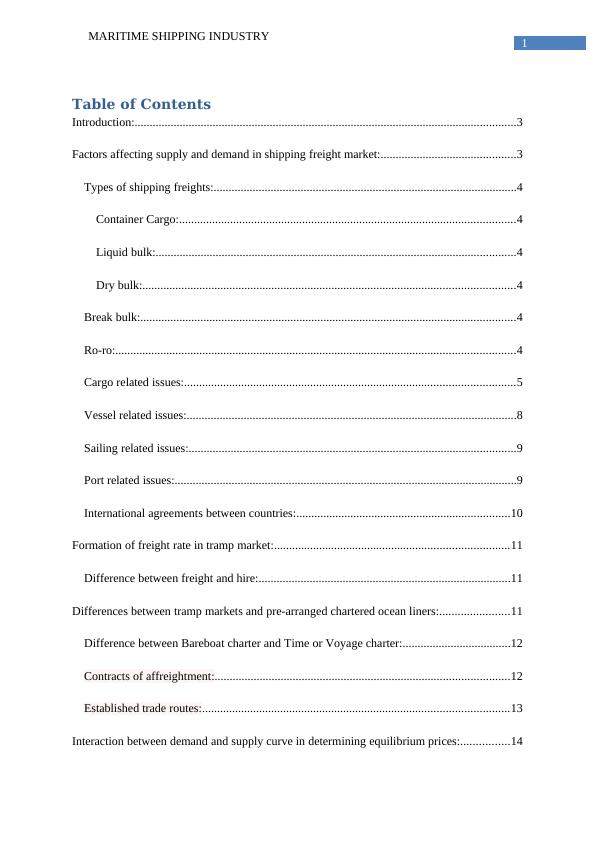
2
MARITIME SHIPPING INDUSTRY
a) Momentary Equilibrium:..................................................................................................14
b) Short run equilibrium:......................................................................................................14
c) Long-run equilibrium:......................................................................................................15
Conclusion:..............................................................................................................................16
References:...............................................................................................................................17
MARITIME SHIPPING INDUSTRY
a) Momentary Equilibrium:..................................................................................................14
b) Short run equilibrium:......................................................................................................14
c) Long-run equilibrium:......................................................................................................15
Conclusion:..............................................................................................................................16
References:...............................................................................................................................17
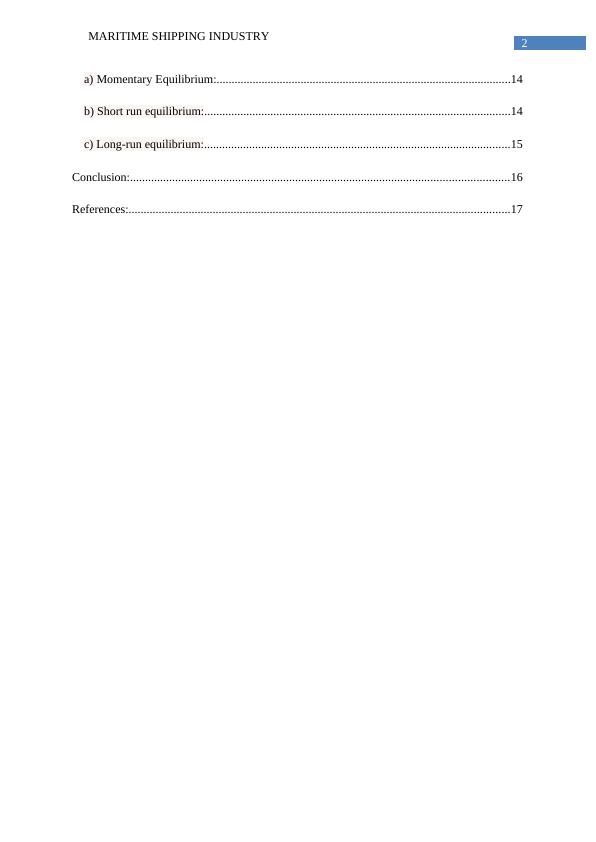
3
MARITIME SHIPPING INDUSTRY
Introduction:
The paper seeks to delve into demand and supply in the shipping freight market in the
world. The paper has three sections, the first deals with the factors effecting demand and
supply in the shipping market, the second section studies the freight rate in tamp shipping
market while the third section applies three types of equilibrium to the shipping to study this
demand and supply. The factors impacting the demand and supply are issues related to cargo,
vessels, sailing, ports and international relations. The tramp freight section delves into diverse
terms like contracts of affreightment and time charter. The final section delves into three
types of equilibrium namely, momentary equilibrium, short-run equilibrium and long-run
equilibrium. The section discusses each of these three equilibrium conditions and interprets
from the view of the shipping industry. The assignment has been provided with graphs and
charts to make the research more substantial and strong. Graphs, figures and charts from
several reliable sources like the European Union, the Baltic Dry Exchange, S & P Global
Platts and the World Shipping Council, which has, strengthen the quality of the data
manifold. The author before embarking on explaining the three sections has given a brief idea
on the types of cargos. A brief idea about the main logistics hubs, the hub and spoke concept
and the main international shipping has also been given. This would help the reader to
comprehend the various aspects of the shipping freight market.
Factors affecting supply and demand in shipping freight market:
There are several factors affecting supply and demand in shipping freight market
internationally like cargo related issues and vessel related issues. The goods transported using
freight carriers can be of five types namely, container cargo, liquid bulk, dry bulk, break-bulk
and Ro-Ro.
MARITIME SHIPPING INDUSTRY
Introduction:
The paper seeks to delve into demand and supply in the shipping freight market in the
world. The paper has three sections, the first deals with the factors effecting demand and
supply in the shipping market, the second section studies the freight rate in tamp shipping
market while the third section applies three types of equilibrium to the shipping to study this
demand and supply. The factors impacting the demand and supply are issues related to cargo,
vessels, sailing, ports and international relations. The tramp freight section delves into diverse
terms like contracts of affreightment and time charter. The final section delves into three
types of equilibrium namely, momentary equilibrium, short-run equilibrium and long-run
equilibrium. The section discusses each of these three equilibrium conditions and interprets
from the view of the shipping industry. The assignment has been provided with graphs and
charts to make the research more substantial and strong. Graphs, figures and charts from
several reliable sources like the European Union, the Baltic Dry Exchange, S & P Global
Platts and the World Shipping Council, which has, strengthen the quality of the data
manifold. The author before embarking on explaining the three sections has given a brief idea
on the types of cargos. A brief idea about the main logistics hubs, the hub and spoke concept
and the main international shipping has also been given. This would help the reader to
comprehend the various aspects of the shipping freight market.
Factors affecting supply and demand in shipping freight market:
There are several factors affecting supply and demand in shipping freight market
internationally like cargo related issues and vessel related issues. The goods transported using
freight carriers can be of five types namely, container cargo, liquid bulk, dry bulk, break-bulk
and Ro-Ro.
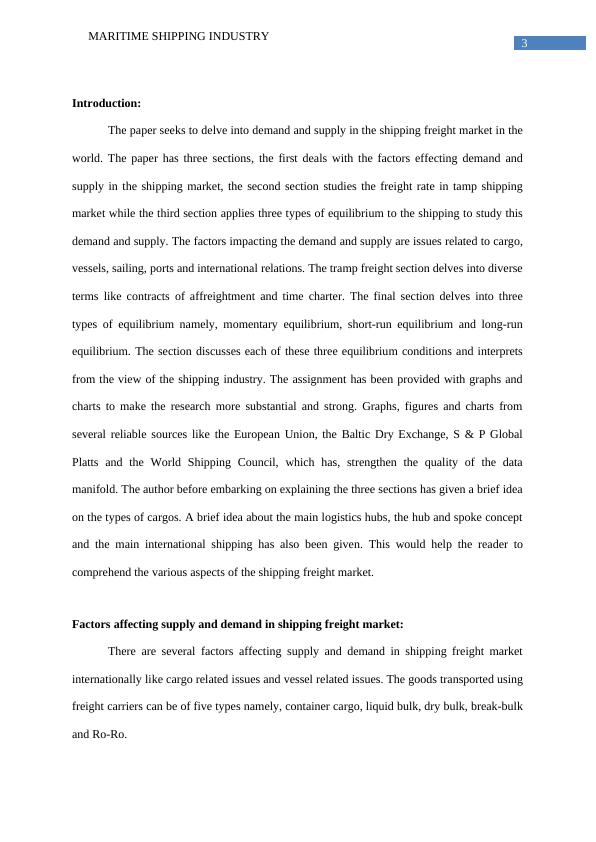
4
MARITIME SHIPPING INDUSTRY
Types of shipping freights:
The section below would contain brief idea about each of these cargo categories, which are as
follows:
Container Cargo:
The container cargo consists of materials, which are transported in containers and are
easily breakable. They consist of FMCG products, electronic goods and food products, which
are packaged before transporting.
Liquid bulk:
The liquid bulk consists of liquid raw materials like crude oil and finished products
like wine, which are transported in bulk. This type of cargo mostly consists of oils of various
types like petrol, kerosene and even vegetable oil.
Dry bulk:
The dry bulk cargos are transported from one port to another in huge bulks. The dry
bulk freight consists of dry commodities like metals , coals, grain, sand , sugar, salt and even
yeasts used for making alcoholic drinks.
Break bulk:
Break bulk cargo consists of commodities, which are broken into parts and racks to
enable easy transport across ports. The category consists of freight goods like paper, wood,
bags of cocoa, rolls of steel and components of heavy machinery like turbines.
Ro-ro:
The roll on/roll off (Ro-Ro) consists of cargo which are loaded and off-loaded easily.
They consist of automobile products like cars, buses, agricultural vehicles like tractors and
threshers and construction vehicles like cranes.
MARITIME SHIPPING INDUSTRY
Types of shipping freights:
The section below would contain brief idea about each of these cargo categories, which are as
follows:
Container Cargo:
The container cargo consists of materials, which are transported in containers and are
easily breakable. They consist of FMCG products, electronic goods and food products, which
are packaged before transporting.
Liquid bulk:
The liquid bulk consists of liquid raw materials like crude oil and finished products
like wine, which are transported in bulk. This type of cargo mostly consists of oils of various
types like petrol, kerosene and even vegetable oil.
Dry bulk:
The dry bulk cargos are transported from one port to another in huge bulks. The dry
bulk freight consists of dry commodities like metals , coals, grain, sand , sugar, salt and even
yeasts used for making alcoholic drinks.
Break bulk:
Break bulk cargo consists of commodities, which are broken into parts and racks to
enable easy transport across ports. The category consists of freight goods like paper, wood,
bags of cocoa, rolls of steel and components of heavy machinery like turbines.
Ro-ro:
The roll on/roll off (Ro-Ro) consists of cargo which are loaded and off-loaded easily.
They consist of automobile products like cars, buses, agricultural vehicles like tractors and
threshers and construction vehicles like cranes.
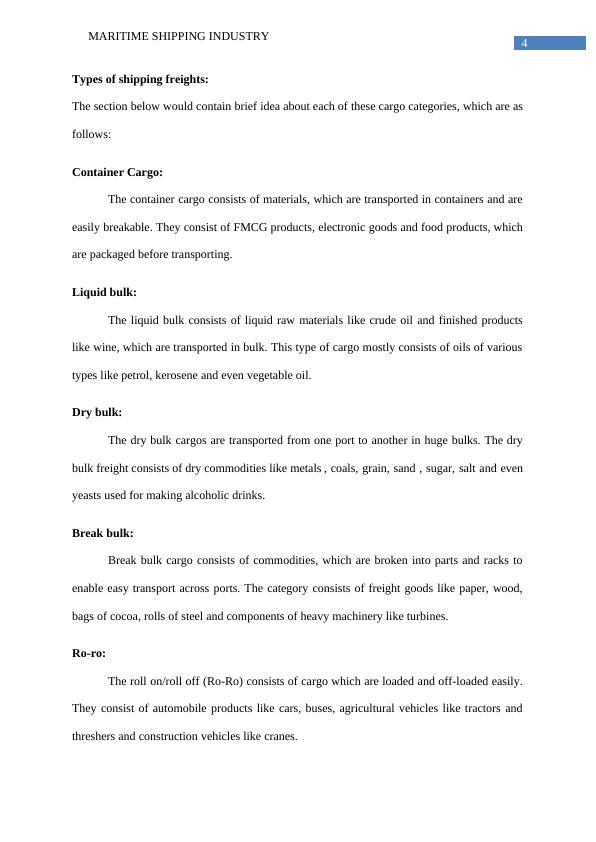
5
MARITIME SHIPPING INDUSTRY
The above-mentioned categories of shipping freight are transported from one port to
another and constitute a large percentage of international trade. Demand and supply plays a
very important role in the shipping freight industry. the following are the factors which effect
the demand and supply in the shipping freight industry:
Cargo related issues:
Cargo related issues are one of the most important factors affecting demand and
supply in the shipping freight industry. According to the World Shipping Council, the
shipping freights across oceans constitute sixty percent of the international trade. The
quantity of goods commercial container ships carry amount to about $ 12 trillion in 2017
(Worldshipping.org. 2017). The cargo ships are now capable of carrying 246 million
deadweight of goods, as per the graph below. The council reports show that the countries
exporting majority of the freights are from the Asia, Europe, North America, South America
and Australia. These markets also account for producing majority of the commodities, which
traded in the freight market. Many commodities like agricultural products are seasonal in
nature. For example, the second figure shows variable wheat export by Ukraine in three years
namely, 2015-16, 2016-17 and 2017-18. Considering the fact that Ukraine is one of the
leading exporters of wheat, the seasonal nature of wheat export means the vessels carrying
wheat freight would be in demand only during certain time of the year.
MARITIME SHIPPING INDUSTRY
The above-mentioned categories of shipping freight are transported from one port to
another and constitute a large percentage of international trade. Demand and supply plays a
very important role in the shipping freight industry. the following are the factors which effect
the demand and supply in the shipping freight industry:
Cargo related issues:
Cargo related issues are one of the most important factors affecting demand and
supply in the shipping freight industry. According to the World Shipping Council, the
shipping freights across oceans constitute sixty percent of the international trade. The
quantity of goods commercial container ships carry amount to about $ 12 trillion in 2017
(Worldshipping.org. 2017). The cargo ships are now capable of carrying 246 million
deadweight of goods, as per the graph below. The council reports show that the countries
exporting majority of the freights are from the Asia, Europe, North America, South America
and Australia. These markets also account for producing majority of the commodities, which
traded in the freight market. Many commodities like agricultural products are seasonal in
nature. For example, the second figure shows variable wheat export by Ukraine in three years
namely, 2015-16, 2016-17 and 2017-18. Considering the fact that Ukraine is one of the
leading exporters of wheat, the seasonal nature of wheat export means the vessels carrying
wheat freight would be in demand only during certain time of the year.

End of preview
Want to access all the pages? Upload your documents or become a member.
Related Documents
Sea Transport and International Tradelg...
|12
|2397
|301
Forecasting of Freight Rates in Large Ore Carrier Shipping Marketlg...
|54
|14581
|1
Assignment on Dry Cargo Charterparties Agreementlg...
|16
|3746
|19
Maritime Transport and Logistics Assignmentlg...
|10
|2174
|331
Forecasting Demand and Supply of Panamax Tanker Market Based on Clarkson's SIN Datalg...
|27
|4711
|22
